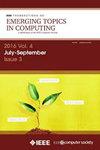Adaptive Task Migration in Multiplex Networked Industrial Chains
IF 5.1
2区 计算机科学
Q1 COMPUTER SCIENCE, INFORMATION SYSTEMS
IEEE Transactions on Emerging Topics in Computing
Pub Date : 2024-02-16
DOI:10.1109/TETC.2024.3364703
引用次数: 0
Abstract
In recent years, the cooperation structures of industrial chains have evolved into multiplex networks, in which product agents are connected through various types of links. Due to the constraints of the multi-coupled interaction structure of the multiplex networked industrial chains, the load imbalances generated by the industrial production processes will cascade in and between different network layers, thus affecting the load balance of the whole system. The challenges that arise when attempting such load balancing among multiplex networked industrial chains are twofold: 1) The multiplex networked interaction structure adds new constraints to traditional multiagent task migration problems, which increases the solution space dimension, and 2) The cascaded load imbalances require tasks to be migrated adaptively, which complicates the solution space structure, and it is proven多路复用网络产业链中的自适应任务迁移
近年来,产业链的合作结构已经演变为多元化的网络,产品代理商通过各种类型的环节连接在一起。由于多路网络化产业链的多耦合交互结构的约束,工业生产过程产生的负载不平衡会在不同的网络层内和网络层之间层叠产生,从而影响整个系统的负载平衡。在多路联网产业链之间尝试这种负载平衡时面临的挑战有两个:1)多路联网交互结构给传统的多智能体任务迁移问题增加了新的约束,增加了求解空间维度;2)级联负载不平衡要求任务自适应迁移,使求解空间结构复杂化,并且证明了这种负载平衡很难实现。然后,设计了一种分层级联触发任务迁移算法,选择关键代理以分层控制的形式相互协作,实现网络层间的负载均衡,并通过级联触发适当的代理自适应迁移任务,实现网络层间的负载均衡。最后,在实验中对该算法进行了广泛的评估,结果表明该算法可以显著提高结果的效用和任务完成率,同时有效地降低任务完成成本。特别是,该算法在最终优化目标上与CPLEX求解器计算的最优结果在统计上似乎没有差异,但它可能消耗更少的运行时间。
本文章由计算机程序翻译,如有差异,请以英文原文为准。
求助全文
约1分钟内获得全文
求助全文
来源期刊

IEEE Transactions on Emerging Topics in Computing
Computer Science-Computer Science (miscellaneous)
CiteScore
12.10
自引率
5.10%
发文量
113
期刊介绍:
IEEE Transactions on Emerging Topics in Computing publishes papers on emerging aspects of computer science, computing technology, and computing applications not currently covered by other IEEE Computer Society Transactions. Some examples of emerging topics in computing include: IT for Green, Synthetic and organic computing structures and systems, Advanced analytics, Social/occupational computing, Location-based/client computer systems, Morphic computer design, Electronic game systems, & Health-care IT.
 求助内容:
求助内容: 应助结果提醒方式:
应助结果提醒方式:


